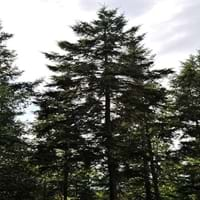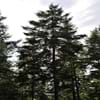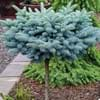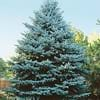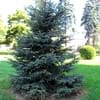Life Span
Perennial
Perennial
Type
Needled or Scaled Evergreen
Tree
Origin
North-Central United States
Australia
Types
Blue Spruce, Norway Spruce, Picea omorika
Not Available
Habitat
Bog Garden, Woodland Garden Canopy
Scrubs, tussock grasslands, Upland savannas
USDA Hardiness Zone
2-7
10-11
Sunset Zone
A1, A2, A3, 1a, 1b, 2a, 2b, 3a, 3b, 4, 5, 6, 7, 14, 15, 16, 17
8, 9, 12, 13, 14, 15, 16, 17, 18, 19, 20, 21, 22, 23, 24
Habit
Pyramidal
Upright/Erect
Flower Color
Not Available
Lemon yellow
Flower Color Modifier
Bicolor
Bicolor
Fruit Color
Not Available
Gray Green
Leaf Color in Spring
Green, Blue Green, Dark Green
Blue Green
Leaf Color in Summer
Blue Green, Dark Green
Blue Green
Leaf Color in Fall
Green, Dark Green
Blue Green
Leaf Color in Winter
Gray Green, Dark Green, Black
Blue Green
Leaf Shape
Needle like
Long Narrow
Plant Season
Spring, Summer, Fall, Winter
Spring
Sunlight
Full Sun, Partial Sun
Full Sun
Type of Soil
Loam
Loam, Sand
The pH of Soil
Acidic, Neutral
Acidic, Neutral, Alkaline
Soil Drainage
Average
Well drained
Bloom Time
Not Available
Spring, Late Winter
Tolerances
Drought
Drought
Where to Plant?
Ground
Ground
How to Plant?
Seedlings, Semi-ripe cuttings
Seedlings
Plant Maintenance
Medium
Medium
Watering Requirements
Average Water Needs, Do Not over Water, Requires regular watering
Do not water excessively
In Summer
Lots of watering
Lots of watering
In Spring
Moderate
Moderate
In Winter
Average Water
Average Water
Soil pH
Acidic, Neutral
Acidic, Neutral, Alkaline
Soil Type
Loam
Loam, Sand
Soil Drainage Capacity
Average
Well drained
Sun Exposure
Full Sun, Partial Sun
Full Sun
Pruning
Remove damaged leaves, Remove dead branches, Remove dead leaves, Remove dead or diseased plant parts
Remove dead or diseased plant parts, Requires little pruning
Fertilizers
All-Purpose Liquid Fertilizer, Apply 12-12-12 amounts, Nitrogen, Phosphorous, Potassium
All-Purpose Liquid Fertilizer, No fertilizers needed
Pests and Diseases
Red blotch
Insects, Root rot
Plant Tolerance
Drought
Drought
Flower Petal Number
Single
Single
Foliage Texture
Fine
Fine
Foliage Sheen
Glossy
Matte
Attracts
Birds
Butterflies
Allergy
Not Available
Asthma, Eye irritation, Headache, Nose Irritation, Throat itching, Vomiting
Aesthetic Uses
Showy Purposes
Showy Purposes
Beauty Benefits
Not Available
Not Available
Environmental Uses
Air purification, Shadow Tree, Wildlife, Windbreak
Air purification, soil stabilisation
Medicinal Uses
Antiseptic, Digestive, Diuretic, Laxative, Pectoral, Poultice, Salve, Skin Disorders, tuberculosis
Not Available
Part of Plant Used
Inner Bark, Seeds
Flowers, Sap, Seeds
Other Uses
Gum, Pitch, Repellent, String, Tannin, Used as a dye, Used for woodware, Used in making musical instruments, Used in paper industry, Waterproofing, Wood is used in construction
Used as a dye, Wood is used fore making tools
Used As Indoor Plant
No
No
Used As Outdoor Plant
Yes
Yes
Garden Design
Feature Plant, Hedges, Screening, Wind Break
Shade Trees, Street Trees
Botanical Name
PICEA glauca 'Densata'
ACACIA aneura
Common Name
White Spruce
Mulga, True Mulga
In Hindi
Black Hills Spruce Tree
Mulga
In German
Weiß-Fichte
Mulga
In French
Épinette blanche
Mulga
In Spanish
Picea glauca
Mulga
In Greek
Black Hills Spruce Tree
mulga
In Portuguese
Pinheiro-do-canadá
Mulga
In Polish
Black Hills Spruce Tree
Mulga
In Latin
Picea glauca
Mulga
Phylum
Coniferophyta
Magnoliophyta
Class
Pinopsida
Magnoliopsida
Clade
Not Available
Angiosperms, Eudicots, Rosids
Tribe
Not Available
Not Available
Subfamily
Barnadesioideae
Not Available
Number of Species
Not Available
Not Available
Importance of Black Hills Spruce and Mulga Tree
Want to have the most appropriate plant for your garden? You might want to know the importance of Black Hills Spruce and Mulga Tree. Basically, these two plants vary in many aspects. Compare Black Hills Spruce and Mulga Tree as they differ in many characteristics such as their life, care, benefits, facts, etc. Every gardener must at least have the slightest clue about the plants he wants to plant in his garden. Compare their benefits, which differ in many ways like facts and uses. The medicinal use of Black Hills Spruce is Antiseptic, Digestive, Diuretic, Laxative, Pectoral, Poultice, Salve, Skin Disorders and tuberculosis whereas of Mulga Tree is Not Available. Black Hills Spruce has beauty benefits as follows: Not Available while Mulga Tree has beauty benefits as follows: Not Available.
Compare Facts of Black Hills Spruce vs Mulga Tree
How to choose the best garden plant for your garden depending upon its facts? Here garden plant comparison will help you to solve this query. Compare the facts of Black Hills Spruce vs Mulga Tree and know which one to choose. As garden plants have benefits and other uses, allergy is also a major drawback of plants for some people. Allergic reactions of Black Hills Spruce are Not Available whereas of Mulga Tree have Asthma, Eye irritation, Headache, Nose Irritation, Throat itching and Vomiting respectively. Having a fruit bearing plant in your garden can be a plus point of your garden. Black Hills Spruce has showy fruits and Mulga Tree has no showy fruits. Also Black Hills Spruce is not flowering and Mulga Tree is not flowering . You can compare Black Hills Spruce and Mulga Tree facts and facts of other plants too.
